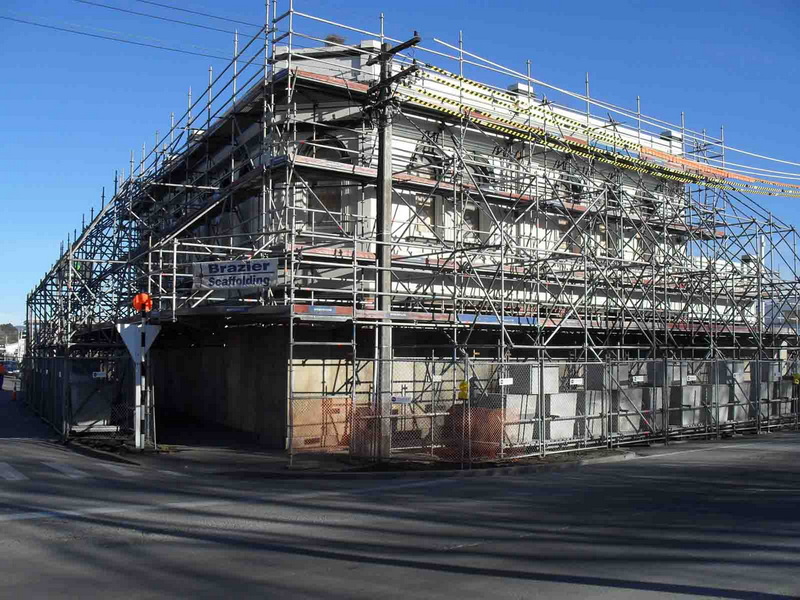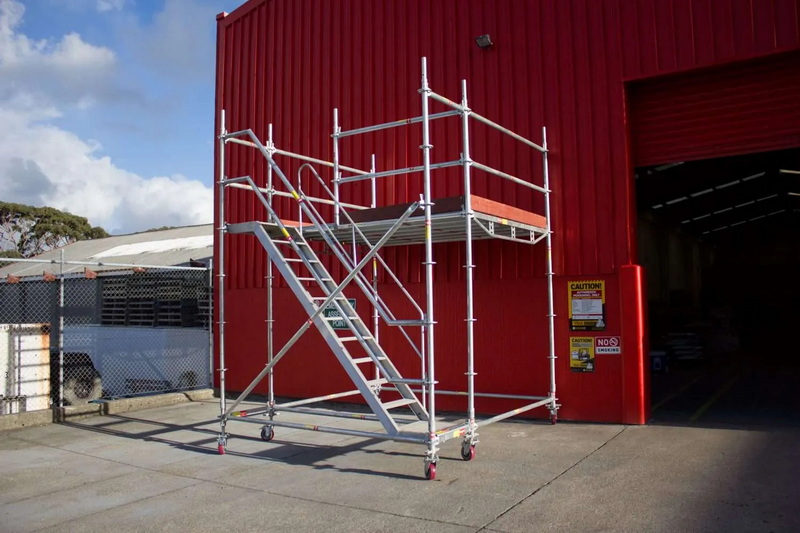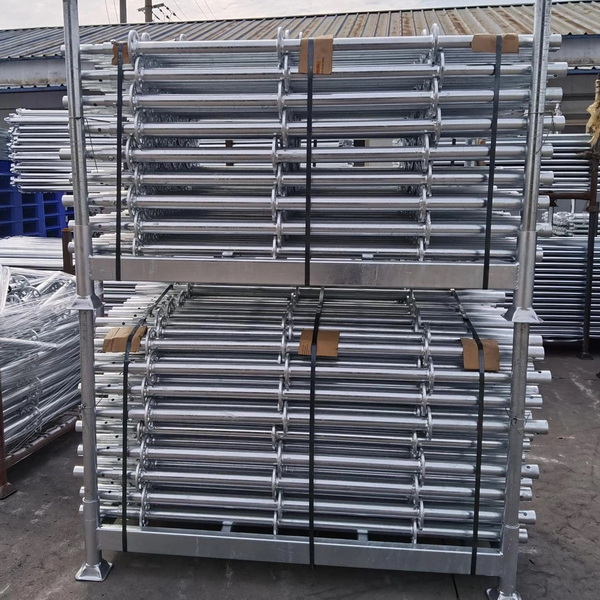Content Menu
● What is Ringlock Scaffolding?
>> Core Components of Ringlock Scaffolding
>> How Ringlock Scaffolding Works
● Why Choose Ringlock Scaffolding for Industrial Use?
>> 1. Versatility and Adaptability
>> 2. High Load Capacity
>> 3. Rapid Assembly and Dismantling
>> 4. Enhanced Safety Features
>> 5. Cost Efficiency
>> 6. Durability in Harsh Environments
● Applications of Ringlock Scaffolding in Industry
>> Oil and Gas Facilities
>> Power Generation Plants
>> Mining Industry
>> Maritime and Shipbuilding
>> Pulp and Paper Industry
>> Chemical and Pharmaceutical Plants
>> Construction and Infrastructure Projects
● Top Features Making Ringlock Scaffolding Ideal for Industrial Use
● Safety and Efficiency Enhancements
>> Fall Protection Integration
>> Assembly Workflow Optimization
>> Regular Inspection and Maintenance
● Accessories and Customization Options for Industrial Tasks
● Comparison: Ringlock Scaffolding vs. Traditional Tubular Systems
● Installation Best Practices for Industrial Ringlock Scaffolding
● Conclusion
● FAQ
>> 1. What makes Ringlock scaffolding better than traditional scaffolding systems for industrial projects?
>> 2. Can Ringlock scaffolding be used on uneven industrial terrain?
>> 3. What industries benefit most from Ringlock scaffolding?
>> 4. How does the safety of Ringlock scaffolding compare to other systems?
>> 5. What accessories are commonly used with Ringlock scaffolding in industrial applications?
In industrial settings, scaffolding solutions must meet stringent demands for safety, load-bearing capacity, versatility, and speed of assembly. Among the many scaffolding types available, Ringlock scaffolding stands out as a top choice for industrial applications. Its modular design, robust steel construction, and adaptable configuration allow for rapid erection of safe and reliable access platforms over a diverse range of complex structures. This article explores the best Ringlock scaffolding solutions tailored for industrial environments, highlighting their unique qualities, applications across various sectors, and why they excel in enhancing productivity and worker safety.

What is Ringlock Scaffolding?
Ringlock scaffolding is a modular, system-based scaffolding that features a unique rosette and wedge-head locking mechanism for quick assembly without the need for bolts or complex tools. The key to its popularity is its simplicity and flexibility, making it ideal for the demanding environments common to industrial projects.
Core Components of Ringlock Scaffolding
- Standards (Vertical posts): Load-bearing pillars that support the structure.
- Ledgers (Horizontal braces): Connect standards horizontally.
- Diagonal braces: Increase rigidity and stability.
- Rosette nodes: Central discs welded to standards where ledgers and braces lock.
- Base jacks: Provide adjustability and level the scaffolding.
This modular system can be assembled into various configurations, including single and double-row scaffolds, rolling scaffolds, and suspended scaffolding platforms.
How Ringlock Scaffolding Works
The design centers around the rosette — a circular disc welded at regular intervals along the vertical standards. Ledgers and braces connect via wedge-head components that lock securely around the rosette using hammers, eliminating the need for nuts and bolts. This mechanism provides both strength and rapid assembly.
Why Choose Ringlock Scaffolding for Industrial Use?
1. Versatility and Adaptability
Ringlock scaffolding can be customized to accommodate a wide array of industrial structures such as tanks, silos, refineries, power plants, shipyards, and mining sites. Its design adapts easily to curves, slopes, and uneven ground—common challenges in industrial terrains.
2. High Load Capacity
Standing out for its strength, Ringlock scaffolding components made from Q355-grade steel offer superior mechanical properties. Each vertical standard can support loads typically between 3 to 4 tons, making it suitable for heavy-duty applications.
3. Rapid Assembly and Dismantling
The wedge-head locking mechanism allows scaffolders to erect or dismantle the structure swiftly, requiring only a hammer to lock components in place, eliminating the need for bolts or screws. This efficiency significantly reduces labor costs and downtime.
4. Enhanced Safety Features
Safety is paramount in industrial settings. Ringlock scaffolding allows for:
- Harness fixation at strategic rosette points during assembly.
- Installation of guardrails ahead of worker arrival to prevent falls.
- Stable platforms that resist wobbling under heavy loads.
5. Cost Efficiency
The modular nature enables material use precisely matched to load and design requirements, minimizing waste. The durability and corrosion resistance of galvanized components further reduce long-term costs. Moreover, the reduced labor time lowers overall project expenditures.
6. Durability in Harsh Environments
Industrial environments often expose scaffolding to chemicals, moisture, and extreme weather. High-quality Ringlock scaffolding is usually hot-dip galvanized or coated with protective paint systems, enhancing corrosion resistance and extending lifespan.
Applications of Ringlock Scaffolding in Industry
Oil and Gas Facilities
In oil refineries and offshore platforms, quick and secure scaffolding solutions like Ringlock reduce plant downtime during maintenance. Advanced safety features protect workers in hazardous environments.
Power Generation Plants
Power and utility plants require scaffolding for high and complex structures like turbines, boilers, and cooling towers. Ringlock scaffolding's modular accessories—platform brackets and stair towers—ensure safe access and compliance.
Mining Industry
Mining operations often occur in harsh environments. The heavy-duty steel construction and adaptable design of Ringlock scaffolding meet these challenges by providing corrosion-resistant, high-strength platforms that conform to uneven terrain.
Maritime and Shipbuilding
Shipyards benefit from the system's flexibility to fit curved hulls and narrow spaces, critical for ship repair and assembly. The scaffolding's robust load capacity ensures safe working platforms at varying elevations.
Pulp and Paper Industry
Maintaining large processing plants involves navigating machinery and pipes. Ringlock scaffolding's flexible configuration minimizes operational downtime by enabling quick access and a secure working environment.
Chemical and Pharmaceutical Plants
Stringent environmental and hygiene regulations necessitate scaffolding that can be quickly erected, inspected, and dismantled. Ringlock scaffolding's quick assembly and corrosion resistance make it ideal for such critical environments.
Construction and Infrastructure Projects
For large industrial constructions such as warehouses, factories, and bridges, Ringlock scaffolding provides temporary yet reliable access for workers and materials at any elevation.

Top Features Making Ringlock Scaffolding Ideal for Industrial Use
| Features | Benefits |
| Modular Design | Customizable for complex geometries and heights |
| Rosette and Wedge Locks | Fast assembly without bolts, stable connections |
| High Load Capacity | Supports heavy equipment and personnel safely |
| Corrosion-resistant Coating | Durable in harsh industrial environments |
| Fall Protection Compatibility | Supports harness attachment and advanced guardrails |
| Lightweight Components | Easier handling reduces worker fatigue during assembly |
Safety and Efficiency Enhancements
Fall Protection Integration
Industrial sites mandate fall protection. Ringlock scaffolding features rosette nodes specially designed to secure safety harnesses, reducing fall risks during construction and maintenance.
Assembly Workflow Optimization
The reduced number of components coupled with the quick-lock mechanism allows scaffolding crews to erect platforms up to five times faster than traditional tube and clamp systems, improving site productivity substantially.
Regular Inspection and Maintenance
Industrial projects often last extended periods. Regular scaffold inspections—using the scaffold's modular documentation and component traceability—ensure ongoing safety compliance and prevent unexpected failures.
Accessories and Customization Options for Industrial Tasks
Ringlock scaffolding can be equipped with various accessories that improve safety and functionality:
- Cantilever brackets: To create expanded work spaces where floor space is limited.
- Suspended scaffold hooks: For hanging platform applications.
- Base plates and adjustable jacks: To accommodate uneven surfaces.
- Guardrails and toe boards: Enhancing fall protection.
- Stair towers and ladders: For safe vertical access.
- Work platforms made of aluminum or metal decks: For heavier-duty tasks.
These options allow seamless adaptation to diverse industrial challenges, from shipbuilding curved hulls to refinery confined spaces.
Comparison: Ringlock Scaffolding vs. Traditional Tubular Systems
| Aspect | Ringlock Scaffolding | Traditional Tube & Clamp Scaffolding |
| Assembly Time | Fast (modular locking, fewer parts) | Slow (requires bolts, screws, manual tightening) |
| Load Bearing Capacity | High (up to 4 tons per standard) | Moderate (depends on tube size and connections) |
| Safety Features | Integrated harness points and guardrails | Limited fall protection integration |
| Flexibility | Highly adaptable to shapes and heights | Less modular, complex on irregular geometries |
| Cost Efficiency | Optimized material use, reduced labor costs | Potentially more material waste and labor expense |
| Component Weight | Lightweight, easier handling | Heavier due to clamps and tubes |
Installation Best Practices for Industrial Ringlock Scaffolding
- Conduct detailed site surveys to identify load requirements and spatial constraints.
- Always verify components against Mill Test Certificates for material quality assurance.
- Pre-plan assembly sequences considering available space and safety requirements.
- Train scaffolders on the wedge-head locking mechanism and safe harness usage.
- Regularly inspect erected scaffolds for stability and any wear during extended projects.
- Use third-party scaffolding experts for quality audits to maintain compliance.
Conclusion
For industrial applications demanding versatility, durability, and fast setup, Ringlock scaffolding offers unparalleled solutions. Its modular rosette and wedge-head lock system combined with its high load capacity and advanced safety features make it the preferred choice across sectors such as oil and gas, mining, shipbuilding, and power generation. Investments in Ringlock scaffolding lead to improved productivity, enhanced worker safety, and optimized costs in the challenging environments typical of industrial use.

FAQ
1. What makes Ringlock scaffolding better than traditional scaffolding systems for industrial projects?
Ringlock scaffolding offers faster assembly, higher load capacity, and better safety integration with harness points and guardrails, making it ideal for the complex, heavy-duty demands of industrial jobs.
2. Can Ringlock scaffolding be used on uneven industrial terrain?
Yes, Ringlock scaffolding can be adapted with base jacks and adjustable components to maintain stability on slopes and uneven ground, common in mining and construction sites.
3. What industries benefit most from Ringlock scaffolding?
Oil and gas, power generation, mining, shipbuilding, pulp and paper, chemical, pharmaceutical, and large industrial plant maintenance benefit significantly due to its ruggedness and customizable design.
4. How does the safety of Ringlock scaffolding compare to other systems?
Ringlock's integrated rosette nodes allow for secure harness attachments and early installation of guardrails, providing better fall protection during assembly and use than most traditional scaffolding.
5. What accessories are commonly used with Ringlock scaffolding in industrial applications?
Accessories include cantilever brackets, suspended scaffold hooks, stair towers, adjustable base plates, guardrails, and toe boards to enhance functionality and comply with safety regulations.






















